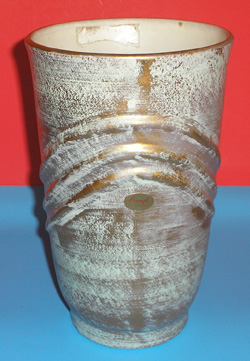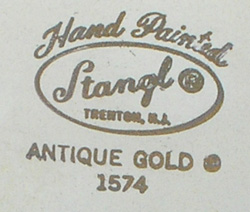 |
|
|||
 |
 |
|||
RINKER ON COLLECTIBLES — Column #1475 Copyright © Harry Rinker, LLC 2015 Questions
and Answers
ANSWER: The website www.stanglpottery.org contains a brief history of Stangl Pottery. In 1814, Samuel Hill established the Hill Pottery in Flemington, New Jersey. The company produced a wide range of utilitarian clay (earthen) wares – drain pipes, jars, and storage crocks. Abram Fulper purchased Hill Pottery in the 1860s. Fulper shifted production from earthenware to stoneware. Under the direction of William H. Fulper II, Abram’s grandson, Fulper Pottery began the production of art pottery in 1909. Martin Stangl, a ceramic engineer, joined Fulper in 1910. By 1924, Martin Stangl was vice president. Under his direction, Fulper began making solid color dinnerware. Stangl became president in 1926. A year after William Fulper II‘s death in 1928, Stangl changed the name of the company to Stangl Pottery. The first Flemington plant burned down in 1929. Production moved to the firm’s Trenton plant. In 1942, Stangl introduced hand carved, hand painted dinnerware. In the 1930s, Stangl opened its famous Flemington Outlet showroom. I remember my mother and her sisters heading off to visit “The Flemington Outlet.” The outlet sold factory seconds, discontinued lines, and test shapes and patterns that were not mass-produced. In addition to dinnerware, Stangl made figurines, most notably birds, and accessory pieces. A gold craze occurred in the late 1950s and early 1960s. Many ceramic manufacturers decorated their dinnerware and accessories with gold accents, using a variety of labels such as “22K Gold.” The amount of gold was miniscule, a fraction of a cent. Any attempt to scrape off the gold for resale is fruitless.
WorthPoint.com lists an example of your vase that sold on eBay in 2007 for $11.10. Although this price is almost 10 years old, it still is valid. Interest in Stangl Pottery, especially the accessories and dinnerware, is a shadow of its former self in the late 1980s and 1990s. The $11.10 value is comparable to prices being asked on eBay today for similar pieces. Frank Wheaton, Jr., bought Stangl Pottery following the death of Martin Stangl in 1972. Phaltzgraff , headquartered in York, Pennsylvania, secured the Stangl trademark and liquidated the remaining inventory in 1978. QUESTION: I have an original, autographed Dan DeCarlo, Archie Comics cartoonist, matted and framed print. The print measures 10 inches by 14 inches. Dan DeCarlo’s signature is on the mat as well as the print. Where can I sell it to achieve its maximum value? – RS, Halesite, NY ANSWER: Cartoonist Daneil S. DeCarlo (December 12, 1919 to December 2001) began his comic book career working for Timely Comics on comics such as “Jeanie” and “Millie the Model.” He is best known for developing the late 1950s and early 1960s contemporary look for the characters in Archie Comics. He also is credited with creating the characters of Sabrina the Teenage Witch, Josie and the Pussycats, and Cheryl Blossom. [See: http://en.wikipedia.org/wiki/Dan_DeCarlo] Based upon your description, it is not clear exactly what you have. My research revealed dozens of signed comic strips, comic book covers, and character drawings of Archie Comics characters. I did not find any Archie related prints, signed or unsigned. Is the subject matter of your print even Archie related? Selling an individual collectible item is difficult. First, the sale venues are limited. eBay is no longer friendly to a one-time seller. This is not the type of item to list on Craigslist. Second, it is far more likely that you will sell to a dealer than a private collector. The good news is that you live near New York City. My first suggestion is to research the major comic book dealers in the greater New York City region and approach them. Second, there are a number of comic cons in your vicinity. Attend one, take your item with you, find a dealer who sells Archie Comics era material, and approach him/her. Just walking around holding the item may attract a buyer. I do not think your item has enough value to attract a major auction house such as Heritage Auctions in Dallas that specializes in autographs and/or comic book art. Do not offer it for sale in a general auction. If selling at auction, you need to consign the piece to a specialized comic book/memorabilia auction. QUESTION: I have a very large Maxfield Parrish collection consisting of prints, books, and additional items. I have spent over 35 years building the collection. I have one daughter who has no interest in the collection. She probably would sell the collection at auction and not do well. I am very attached to my collection and do not want to see it broken up. Are they any options of which you are aware that would help me decide what to do with the collection? – DI, Storm Lake, IA ANSWER: Except for his period paintings and illustrations, the secondary market for Maxfield Parrish items has fallen on hard times. To my regular readers, the preceding statement “sounds like a stuck record,” but, it is true nonetheless. [Author’s Aside: The difficulty with a reference such as “sounds like a stuck record” is that in order to be understood, the listener has to have lived during the period when phonographs and 33 1/3, 45, and 78 rpm records were commonplace in the American household. Although I own several CD players, including one in my car, I rarely use them. If memory serves correctly, I have never experienced a stuck disk in terms of sound, only in relationship to removing it from the player. Alas, a few of my 33 1/3 rpm records do stick when I play them on my high-fidelity setup in Florida.] If your collection is going to be sold, it is better you rather than your daughter sell it. If you chose this route, the process will be painful. Financially, the collection will not yield what you think it is worth. Accepting the concept that some money is better than no money is not likely to happen in your case. Donation appears to be your best option. Put aside any hope of selling the collection to a non-profit institution. Unless you have some scarce period Parrish manuscript, artwork, or other items, there will be no interest. Further, most non-profit institutions, like art museums, libraries, and historical museums and sites, are object rich and cash poor. When offered a collection with the proviso that the collection must be kept intact, the non-profit will most likely indicate an interest only if the gift is accompanied by a financial donation large enough to cover the expense of the collection’s annual maintenance. While bleak, your situation is not hopeless. Maxfield Parrish attended Haverford College (Haverford, Pennsylvania) in 1892. The Haverford College Library has a large Maxfield Parrish collection. The Rauner Special Collections Library at Dartmouth College (Hanover, New Hampshire) is home to Parrish’s personal and professional papers and correspondence. The National Museum of American Illustration (Newport, Rhode Island) also has a large Maxfield Parrish collection. Many art museums, such as the Birmingham Museum of Art, have Parrish collections. Given the extent of your collection, I would not overlook the possible interest of a large university library in your area. As mentioned earlier, I doubt if any institution will agree to keep your collection intact. If you find one that will, you are fortunate. I am not certain I have provided the answer for which you hoped. Hopefully, I have given you a number of considerations about which to think and pointed you in some positive directions. QUESTION: I have an alligator handbag that is marked “Made in Cuba.” I think it dates from the 1950s. Does it have any value? – M, Reading PA ANSWER: Your question evoked two memories. The first is the 1950s dead alligator handbag craze, especially bags featuring the head of the alligator on the front. The second is the deteriorating, dried out alligator handbags that appeared on the secondary market in the late 1980s and 1990s. What was once considered junk is now desirable, a fact proven by a quick check of asking prices on eBay. There are four quality levels of alligator handbags. The first is the dead alligator head variety. If in usable condition, these are now $25.00 to $40.00 pieces. The second is a medium quality level bag, well made and with a nice lining. These are in the $50.00 to $70.00 range. The third is a high-quality bag, both in workmanship and quality of the skin. These bags are in the $75.00 to $125.00. The final category is the designer versions. These sell in the middle to high hundreds, over a thousand if the brand name is Vuitton.Harry L. Rinker welcomes questions from readers about
collectibles, those mass-produced items from the twentieth and twenty-first centuries.
Selected letters will be answered in this column.
Harry cannot provide personal answers.
Photos and other material submitted cannot be
returned.
Send your questions to: Rinker on Collectibles, 5955 Mill
Point Court SE, Kentwood, MI 49512.
You also can e-mail your questions to
harrylrinker@aol.com.
Only e-mails containing a full name and mailing address
will be considered.
You can listen
and participate in
WHATCHA GOT?, Harry’s
antiques and collectibles radio call-in show, on Sunday mornings between 8:00 AM
and 10:00 AM Eastern Time.
If you
cannot find it on a station in your area,
WHATCHA GOT?
streams live on the Internet at www.gcnlive.com.
SELL, KEEP OR TOSS?: HOW TO DOWNSIZE A HOME,
SETTLE AN ESTATE, AND APPRAISE PERSONAL PROPERTY
(House of Collectibles, an imprint of Random House Information Group, $17.99),
Harry’s latest book, is available at your favorite bookstore and via
www.harryrinker.com.
|
||||
 QUESTION: I found a Stangl vase in our attic. The vase measures 8 1/2 inches high. The top is 5 1/8 inches in diameter and the base 3 1/2 inches in diameter. The bottom is marked “Hand Painted / [Stangl circular logo] /ANTIQUE GOLD/ 1574” A sticker on the side reads “Stangl / 22KT GOLD.” What can you tell me about my Stangl vase? – RD, Kutztown, PA, Email Question
QUESTION: I found a Stangl vase in our attic. The vase measures 8 1/2 inches high. The top is 5 1/8 inches in diameter and the base 3 1/2 inches in diameter. The bottom is marked “Hand Painted / [Stangl circular logo] /ANTIQUE GOLD/ 1574” A sticker on the side reads “Stangl / 22KT GOLD.” What can you tell me about my Stangl vase? – RD, Kutztown, PA, Email Question “1574” is a mold number. Harvey Duke’s “Stangl Pottery” (Wallace Homestead: 1992) contains a detailed list of numbered Stangl mold shapes.
“1574” is a mold number. Harvey Duke’s “Stangl Pottery” (Wallace Homestead: 1992) contains a detailed list of numbered Stangl mold shapes.